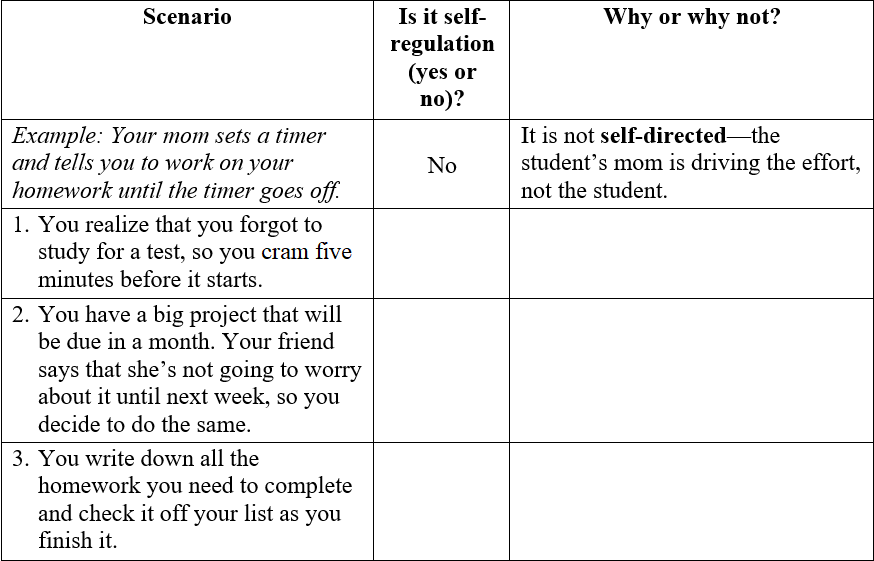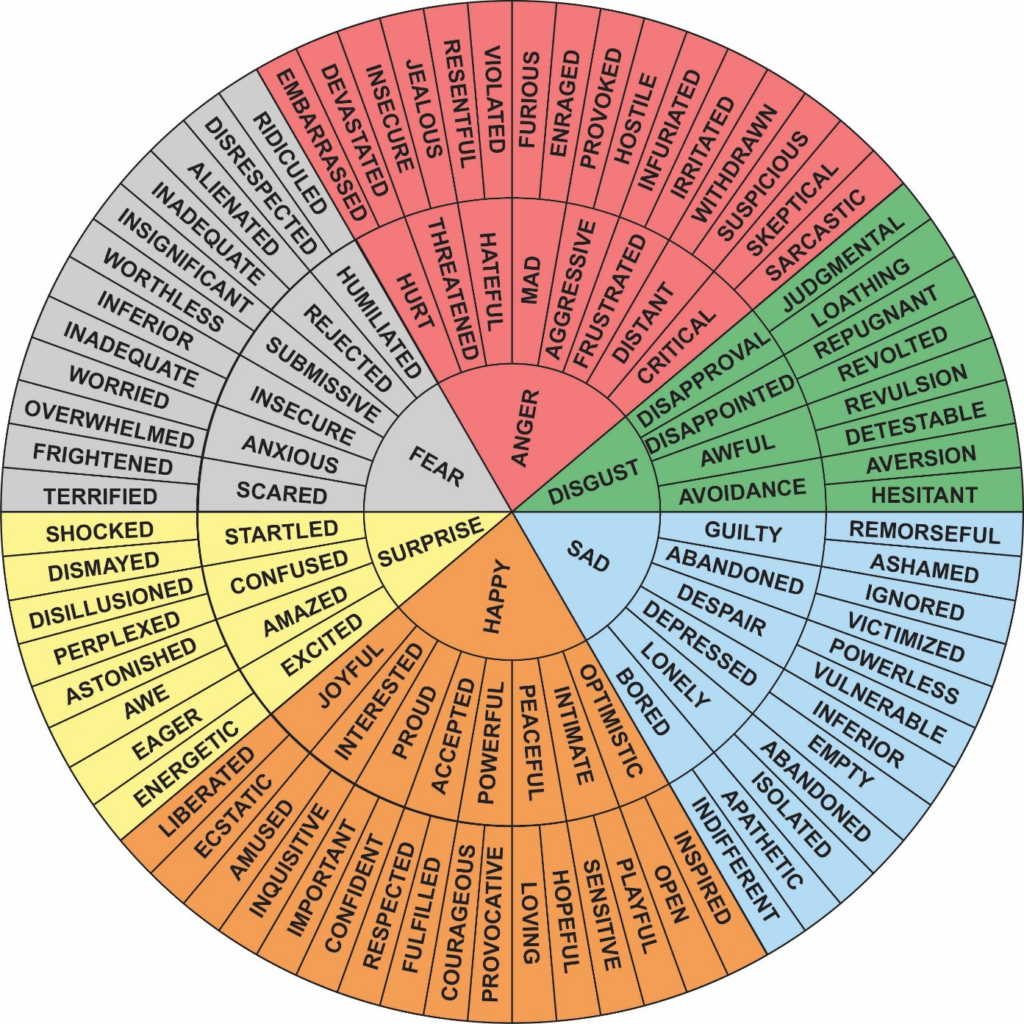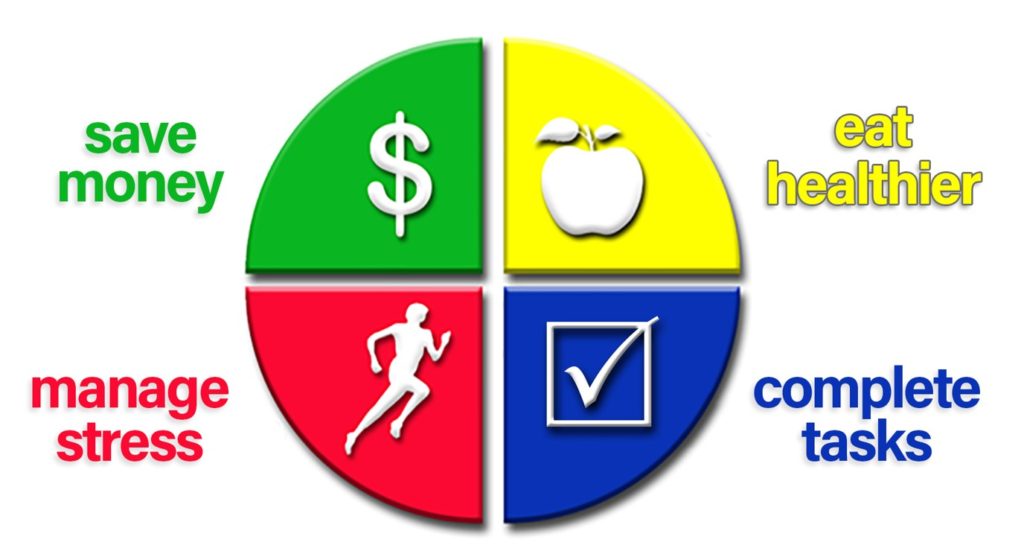Part 1: Teaching Students What Self-Regulation Is and Why It Is Important
- Teach Students: 1a. Defining Self-Regulation
- Teach Students: 1b. Is This Self-Regulation?
- Teach Students: 1c. Planning Emotional Regulation
- Teach Students: 1d. We Already Self-Regulate
- Teach Students: 1e. Self-Regulation Is Important to Me
Part 2: Helping Students Understand Their Strengths and Challenges in Self-Regulation
Part 3: Teaching Students to Plan
Part 4: Embedding Opportunities for Students to Practice Self-Regulation
Part 1: Teaching Students What Self-Regulation Is and Why It Is Important
Learning Target: Students can define self-regulation, give examples of what they might self-regulate, and explain why self-regulation is important in their own lives.
Students need to understand self-regulation and why it is important in their lives. Each activity in Part 1 is designed to help students meet this learning target.
To begin, students need to understand that self-regulation is a process that can be learned; it’s not an innate skill. The first component, make a plan, helps students create detailed plans for accomplishing specific tasks or working toward personalized goals. As we explore this component more, you will learn ways to support students in making detailed plans.
Teach Students: 1a. Defining Self-Regulation
Show students the video of a high school senior, Izzy, defining self-regulation.
After showing the video, facilitate a discussion of the definition of self-regulation. Use the prompts below to help generate discussion from the students:
- What does “attaining” mean? How does this look? Do you think you have to attain your goal to succeed in self-regulation?
- Individually, rewrite the definition of self-regulation in your own words.
Ask students to write their responses to each prompt using the “Teach Students: 1a. Defining Self-Regulation” handout (Handout 1a. linked to on page 11 of your Educator Workbook). Once students have completed the activity, review the answers as a group, providing guidance.
Teach Students: 1b. Is This Self-Regulation?
Ask students to read each scenario in the chart below and fill out the “Teach Students: 1b. Is This Self-Regulation?” handout (Handout 1b. linked to on page 11 of your Educator Workbook), determining the correct answer. This activity will help you assess your students’ understanding of self-regulation. As your students discuss each scenario, provide detailed reasons why the scenario is or is not self-regulation.

Scenario 1 is not self-regulation because you did not follow the process and use the four components to help you prepare for the test. Scenario 2 is not self-regulation because none of the components were used and you’re not self-directing your efforts. Finally, Scenario 3 might represent self-regulation. For example, you have a plan to write down your homework, and you are monitoring your plan by checking off each assignment as you finish it, but you haven’t yet applied the entire process of self-regulation. You need to reflect to determine if your plan is working and adjust as needed. Students must understand that there are times when we think we are self-regulating but we haven’t addressed all four components in the process.
As students begin to learn about self-regulation, you may see their initial plans look similar to Scenario 3 in the chart. While Scenario 3 is a good start for making a self-regulation plan, it lacks specificity, such as determining when homework will be completed, allocating enough time for homework, managing distractions, and ensuring that all homework is turned in.
It is also vital for students to understand that plans are fluid. Therefore, students should reflect on how well their plan is working throughout the process, and they may need to adjust the actions in their plan several times before they accomplish a task.
1b. Reflect and Apply: Watch this video of Dr. Amy Gaumer Erickson facilitating the instructional activity “Teach Students: 1b. Is This Self-Regulation?” As you watch the video, think about how you will present this activity to your students.
- How and when would you facilitate this activity with your students?
- Would you use the same scenarios or modify them to make them more relatable to your students?
- What do you anticipate will be difficult for your students to understand about this activity? What are other ways you could teach these concepts?
Jot your thoughts down on page 3 of your Educator Workbook.
When we think about self-regulation, it is crucial to include regulating our emotional reactions, especially when we feel stressed, overwhelmed, or frustrated. We feel a range of emotions every day and need to be able to identify those emotions and regulate how we express them. We have more control over emotional reactions when using coping mechanisms or calming strategies.
In our next activity, students are introduced to the concept of regulating emotional reactions.
Once students understand that we can regulate our responses to our emotions through our thoughts and our actions, introduce them to the Feeling Words Wheel, found on the “Teach Students: 1c. Planning Emotional Regulation” handout (Handout 1c. linked to on page 11 in your Educator Workbook; Thinkmap, 1998) as a tool for helping them identify their emotions. The emotions in the center ring are basic, but as you move toward the outer ring, the emotions become more complex. For example, when asked about their emotions, students may typically respond with emotions in the center, such as sad, happy, or angry. Help students identify more complex emotions by asking them to explain a situation using more complex emotions on the middle and outer ring to describe how they were feeling.
As students get better at identifying emotions, they can begin to identify physiological changes (e.g., increased heart rate, feeling hot, turning red) as they experience emotions. Consider sharing a personal example that illustrates identifying emotions and using strategies to address the physiological changes to regulate how we respond to emotions.
Watch this video as Dr. Amy Gaumer Erickson provides an example of how she identified her feelings about a task and her self-regulation strategies.
Teach Students: 1c. Planning Emotional Regulation
Introduce the concept of regulating emotional reactions to students by showing this short video Emotions and the Brain (Sentis, 2012). After watching the video, explain to students that we all feel a range of emotions every day but that it’s important to identify and regulate how we express them. As a result, we have more control over emotional reactions when using coping mechanisms or calming strategies.

Provide students with a copy of the Feeling Words Wheel, found on the “Teach Students: 1c. Planning Emotional Regulation” handout (Handout 1c. linked to on page 11 in your Educator Workbook; Thinkmap, 1998) to help them better identify their emotions. Next, have students work with a partner to review and discuss some of the complex feelings from the two outer rings. Emphasize that feelings often cause physiological changes to our bodies; encourage students to discuss the physiological changes (e.g., increased heart rate, feeling hot, turning red) they’ve experienced with complex feelings. Finally, have students discuss coping mechanisms, strategies, or tools they have used or could use to manage their emotional reactions. When students understand why they feel a certain way, they can begin to plan for how they might handle that emotional reaction.
1c. Reflect and Apply: Think about a time when you recently experienced an emotional reaction:
- What emotions were you feeling? What physiological changes did you experience because of the emotions?
- What coping strategies did you use to manage your emotional reaction?
- What additional strategies might you consider the next time you feel these emotions?
Write your thoughts on page 3 of the Educator Workbook. Consider sharing your example with your students. Emphasize that once we become aware of our complex emotions and physiological reactions related to those emotions, we can use coping strategies—such as deep breathing and taking a walk—to manage our emotional reactions.
We have all tried to regulate various things throughout our lives. Saving money, eating healthier, exercising more, drinking more water, managing stress, and completing tasks are probably things you have worked to self-regulate.
At this point in your self-regulation instruction, your students are beginning to understand that self-regulation can help them accomplish goals related to academics, extracurricular activities, and emotions.
Teach Students: 1d. We Already Self-Regulate

Explain that there are many things that students already work on self-regulating, even if they haven’t realized that’s what they’re doing. As a class, ask your students to brainstorm a list of ten things they currently self-regulate. Have students keep this list for future reference. Provide guidance or additional suggestions as necessary.
Examples might include:
- paying attention
- time on electronics
- calmly responding when feeling frustrated
- independent reading
- getting to school and work on time
- getting homework done
- remembering supplies needed for school
- washing uniform for a sport
Next, have students list three things that they are already self-regulating successfully and three things they want to self-regulate more successfully. They can either choose items that apply to their lives from the class list or add new items of their own. (Print the “Teach Students: 1d. We Already Self-Regulate” handout linked to on page 11 in your Educator Workbook.)
1d. Reflect and Apply: Think about something you have recently accomplished:
- How did you self-regulate to accomplish your goal (e.g., remembering to think positively, getting up earlier, completing smaller tasks on time)?
- Which components (plan, monitor, adjust, reflect) were your strongest?
Jot down your thoughts on page 4 of the Educator Workbook and consider sharing your example with your students.
Students are asked in the next activity to identify why self-regulation is important to them. When we focus on helping students identify a personal connection between things they want to accomplish and learning self-regulation, it will increase their engagement in learning.
People self-regulate to accomplish steps toward achieving their goals. Students who have learned about self-regulation (and consistently use it in school) experience benefits such as completing more of their homework on time, doing better in their classes, and feeling more in control of their learning (Gaumer Erickson & Noonan, 2021).
Teach Students: 1e. Self-Regulation Is Important to Me
Explain to students that people self-regulate to accomplish steps toward achieving their goals. Self-regulation is not only related to success in school but also in many other areas, such as sports, extracurricular activities, jobs, social situations, and personal goals. Explain that students who have learned about self-regulation have experienced benefits such as completing more of their homework on time, feeling more in control of their learning and their upcoming tasks, getting better at organization and time management, learning more in their classes, and figuring out specific reasons they are struggling with something and directly addressing those complications. They have also gained a better understanding of how specific actions they take (or don’t take) have an impact on their progress and overall success. Self-regulation is not just for academics; it can also be applied to improving musical/artistic/athletic ability, maintaining control over your emotional reactions, or reaching any other goal. Tell students that these are just some of the benefits of using self-regulation consistently. We will identify other things that we could work on improving in our academics, personal lives, work responsibilities, and extracurricular activities.
Ask students to respond to the two prompts below with their personal reasons.
Getting better at self-regulation is important to me because: _________________________.
Two specific things that I want to better self-regulate are: __________ and __________.
Read students’ responses to determine how your students understand the need for self-regulation.



